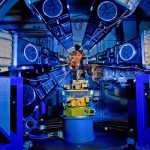
S. Huotari and co-workers [J. Synchrotron. Rad. (2017), 24, 521-530] describe an end-station for X-ray Raman spectroscopy at beamline ID20 of the European Synchrotron Radiation Facility. The end-station is dedicated to the study of shallow core electronic excitations using non-resonant inelastic X-ray scattering.
X-ray Raman scattering (XRS) spectroscopy is a versatile tool for studying shallow X-ray absorption edges using hard X-rays. It has proven to be an invaluable technique for the study of electronic excitations in a variety of sample systems such as crystals, liquids and gases. Over the past decades, XRS has been applied to solve geoscientific questions by studying shallow core edges under extreme pressure and temperature conditions, follow chemical reactions in situ, and study liquid samples under well defined thermodynamic conditions.
A drawback of XRS is the orders-of-magnitude weaker scattering cross section in comparison with the probability for photoelectric absorption. This can be compensated for by using light sources with a very high brilliance and efficient signal collection; this has been the guiding motive for the design of the spectrometer presented in this paper.
The new end-station provides an unprecedented instrument for X-ray Raman scattering, and will open the door to renewed studies of low-energy X-ray absorption spectra in materials under in situ conditions, such as operando batteries and fuel cells, in situ catalytic reactions, and extreme pressure and temperature conditions.